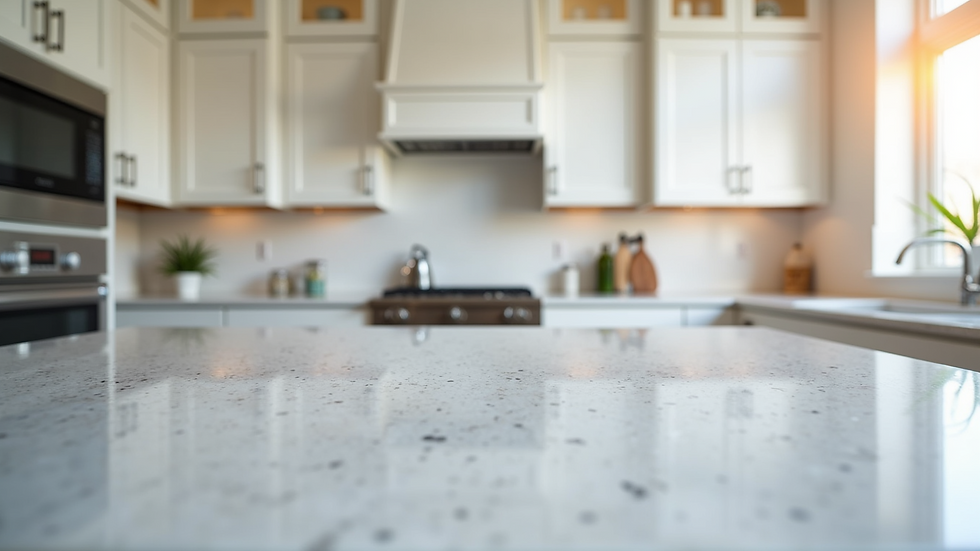Achieving Harmony with Cabinets and Countertops
- Jacob Klatt

- Nov 18
- 4 min read
When it comes to updating your kitchen, one of the most important decisions you’ll make is how to coordinate your cabinets and countertops. These two elements set the tone for the entire space, influencing both style and functionality. I’ve spent a lot of time helping homeowners find the perfect balance, and I’m excited to share practical tips and insights that will make your kitchen transformation smooth and satisfying.
Why Coordinating Cabinets and Countertops Matters
Choosing cabinets and countertops that complement each other is more than just a design choice - it’s about creating a cohesive look that feels intentional and inviting. When these elements clash, the kitchen can feel disjointed or chaotic. But when they harmonize, the space feels balanced and welcoming.
Here are some reasons why coordination is key:
Visual Flow: Matching tones and textures help the eye move naturally around the room.
Enhanced Style: Coordinated materials elevate the overall aesthetic, whether modern, rustic, or traditional.
Increased Home Value: A well-designed kitchen is a major selling point for potential buyers.
Personal Satisfaction: You’ll enjoy spending time in a kitchen that feels thoughtfully put together.
For example, pairing sleek white cabinets with a marble countertop creates a timeless, elegant look. On the other hand, dark wood cabinets with a light granite countertop can add warmth and contrast.

Tips for Coordinating Cabinets and Countertops
When you’re ready to select your cabinets and countertops, keep these practical tips in mind:
1. Start with a Color Palette
Choose a color scheme that reflects your style. Neutral tones like whites, grays, and beiges are versatile and timeless. If you prefer bold colors, consider how they will interact with natural stone or engineered surfaces.
2. Consider Material Compatibility
Some materials naturally complement each other. For instance:
Wood cabinets pair beautifully with quartz or granite countertops.
Laminate cabinets work well with solid surface countertops.
Painted cabinets can be paired with almost any countertop material, depending on the finish.
3. Balance Patterns and Textures
If your cabinets have a strong grain or pattern, opt for a more subtle countertop. Conversely, if your countertop has a busy pattern, choose simpler cabinet finishes.
4. Use Samples and Swatches
Always bring samples of your cabinet finishes when shopping for countertops. This helps you see how the colors and textures look together in your kitchen’s lighting.
5. Think About Maintenance
Some countertop materials require more upkeep than others. Make sure your choice fits your lifestyle and cleaning preferences.
6. Don’t Forget the Hardware
Cabinet handles and knobs can tie the look together. Choose finishes that complement your countertop’s tones and textures.
By following these tips, you’ll create a kitchen that feels cohesive and stylish.
Exploring Popular Cabinet and Countertop Combinations
There are many classic and trendy combinations that work well together. Here are a few favorites I often recommend:
White Cabinets + Quartz Countertops
This combo is bright, clean, and modern. Quartz is durable and low-maintenance, making it perfect for busy kitchens.
Dark Wood Cabinets + Light Granite Countertops
The contrast adds depth and warmth. Granite’s natural patterns add visual interest without overwhelming the space.
Gray Cabinets + Marble Countertops
Gray cabinets offer a neutral base that pairs beautifully with the luxurious veining of marble.
Painted Cabinets + Butcher Block Countertops
For a cozy, farmhouse vibe, painted cabinets in soft colors combined with warm wood countertops create a welcoming atmosphere.
Two-Tone Cabinets + Neutral Countertops
Using two cabinet colors (like navy lower cabinets and white uppers) with a neutral countertop can add dimension and style.

How to Choose the Right Cabinet and Countertop for Your Space
Selecting the perfect combination depends on your kitchen’s size, lighting, and overall style. Here’s a step-by-step approach I recommend:
Assess Your Kitchen’s Lighting: Natural light can affect how colors appear. Test samples in different lighting conditions.
Define Your Style: Are you aiming for modern, traditional, rustic, or transitional? This will guide your material and color choices.
Set a Budget: Countertops and cabinets vary widely in price. Knowing your budget helps narrow options.
Think About Functionality: Consider how you use your kitchen. Do you need heat-resistant surfaces? Easy-to-clean materials?
Consult Professionals: If you’re unsure, working with a designer or contractor can provide valuable insights.
Explore Local Options: Since you’re within roughly 60 miles of Saint Cloud, MN, check out local suppliers and showrooms to see materials in person.
If you want to see some inspiring examples of coordinated cabinet and countertop projects, I highly recommend checking out this cabinet and countertop gallery. It’s a great resource to visualize how different combinations come together.
Final Thoughts on Creating a Harmonious Kitchen
Achieving harmony between your cabinets and countertops is a rewarding process that transforms your kitchen into a space you love. By focusing on color, material, texture, and function, you can create a kitchen that is both beautiful and practical.
Remember, the key is to balance your personal style with smart choices that enhance your home’s value and usability. Whether you prefer classic elegance or modern simplicity, the right coordination will make your kitchen stand out.
If you’re ready to start your kitchen update, take your time exploring options and don’t hesitate to reach out for expert advice. Your dream kitchen is within reach!
Happy renovating!



Comments